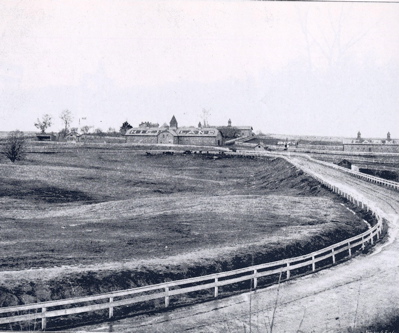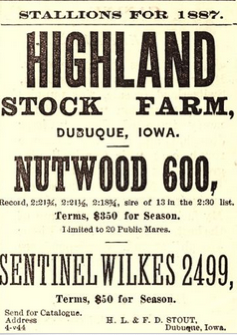Encyclopedia Dubuque
"Encyclopedia Dubuque is the online authority for all things Dubuque, written by the people who know the city best.”
Marshall Cohen—researcher and producer, CNN
Affiliated with the Local History Network of the State Historical Society of Iowa, and the Iowa Museum Association.
HIGHLAND STOCK FARM: Difference between revisions
No edit summary |
No edit summary |
||
| Line 1: | Line 1: | ||
[[Image:imp520.jpg|left|thumb|350px|The word HIGHLAND is clearly written on the roof of the barn.Photo courtesy: Bob Reding]]HIGHLAND STOCK FARM. According to Oldt's '''History of Dubuque County, Iowa''' in 1883 [[STOUT, Henry L.|Henry L. STOUT]] purchased the five hundred acre Carter and Cheney (Chaney) farm and developed the land as a stockfarm. Twenty to thirty fine horses were there at all times except during the racing season. | [[Image:imp520.jpg|left|thumb|350px|The word HIGHLAND is clearly written on the roof of the barn.Photo courtesy: Bob Reding]]HIGHLAND STOCK FARM. According to Oldt's '''History of Dubuque County, Iowa''' in 1883 [[STOUT, Henry L.|Henry L. STOUT]] purchased the five hundred acre Carter and Cheney (Chaney) farm and developed the land as a stockfarm. Twenty to thirty fine horses were there at all times except during the racing season. | ||
In 1895 the site was incorporated with a capital stock of $24,000. (1) A half-mile track and a quarter-mile covered track were constructed along with stables. Brood mares, brought from across the United States, were bred to [[NUTWOOD]], the prized stallion owned by the Stouts. Breeding was done on a cash basis with each mare costing approximately one thousand dollars | In 1895 the site was incorporated with a capital stock of $24,000. (1) A half-mile track and a quarter-mile covered track were constructed along with stables. Brood mares, brought from across the United States, were bred to [[NUTWOOD]], the prized stallion owned by the Stouts. Breeding was done on a cash basis with each mare costing approximately one thousand dollars. John E. Owens, an agent for Dr. R. Davis of Wilkesbarre, Pennsylvania paid $7,500 cash. (2) By the end of his career, Nutwood had earned the Stout family $650,000. (3) | ||
[[Image:highland1.png|left|thumb|350px|]]Stock from the farm were taken for sale as far away as New York City. In 1897 fourteen racing stock were taken for sale to Madison Square Garden. ( | [[Image:highland1.png|left|thumb|350px|]]Stock from the farm were taken for sale as far away as New York City. A carload of trotting and pacing horses, largely of Nutwood stock, were shipped to New York City in December of 1896. (4) In 1897 fourteen racing stock were taken for sale to Madison Square Garden. (5) | ||
In 1899, three years after the death of Nutwood, the Stouts sold all their horses and closed the farm. Stout died the next year and willed the farm to his son [[STOUT, Frank D.|Frank D. STOUT]]. When business kept Frank away from Dubuque, he divided the farm. The stables, tracks, and stock barns were given to his sister, [[STOUT, Fannie|Fannie STOUT]]. | In 1899, three years after the death of Nutwood, the Stouts sold all their horses and closed the farm. Stout died the next year and willed the farm to his son [[STOUT, Frank D.|Frank D. STOUT]]. When business kept Frank away from Dubuque, he divided the farm. The stables, tracks, and stock barns were given to his sister, [[STOUT, Fannie|Fannie STOUT]]. | ||
Fannie, who had received what became Egelhof-Casper-Strueber funeral home as a wedding gift from her father, had the outdoor track seeded and the area within the track flooded to make a pool. ( | Fannie, who had received what became Egelhof-Casper-Strueber funeral home as a wedding gift from her father, had the outdoor track seeded and the area within the track flooded to make a pool. (6) White swans were imported to live in the pond and the covered track and farm buildings were demolished. | ||
Fannie died on December 28, 1914, with an unsigned will. The property became part of the estate and was purchased by [[NAGLE, Joseph J.|Joseph J. NAGLE]] who sold the land to the Sisters of Mercy. Fannie's house was replaced with a brick building in 1921. Later this building was purchased by the [[ARCHDIOCESE OF DUBUQUE]] and the Province of Iowa. A new building was constructed facing the lake. This complex of buildings, known as [[MOUNT ST. BERNARD SEMINARY]], was opened in 1951. In 1969 the [[SISTERS OF THE PRESENTATION OF THE BLESSED VIRGIN MARY (PBVM)]] took possession of the property and called it Mount Loretto. | Fannie died on December 28, 1914, with an unsigned will. The property became part of the estate and was purchased by [[NAGLE, Joseph J.|Joseph J. NAGLE]] who sold the land to the Sisters of Mercy. Fannie's house was replaced with a brick building in 1921. Later this building was purchased by the [[ARCHDIOCESE OF DUBUQUE]] and the Province of Iowa. A new building was constructed facing the lake. This complex of buildings, known as [[MOUNT ST. BERNARD SEMINARY]], was opened in 1951. In 1969 the [[SISTERS OF THE PRESENTATION OF THE BLESSED VIRGIN MARY (PBVM)]] took possession of the property and called it Mount Loretto. | ||
| Line 21: | Line 21: | ||
3. Kerker | 3. Kerker | ||
4. " | 4. "Caught on the Fly," ''Dubuque Herald'', December 17, 1896, p. 4 | ||
5. Fedler, Fred. "Dubuque's Nutwood Park Once Nation's Horse Racing Capital," ''Telegraph Herald'', Undated article. Courtesy of: Diane Harris. | 5. "The Horse Sale," ''Dubuque Herald'', January 30, 1897, p. 5 | ||
6. Fedler, Fred. "Dubuque's Nutwood Park Once Nation's Horse Racing Capital," ''Telegraph Herald'', Undated article. Courtesy of: Diane Harris. | |||
Oldt, Franklin T. '''History of Dubuque County'''. http://www.ebooksread.com/authors-eng/franklin-t-oldt/history-of-dubuque-county-iowa-being-a-general-survey-of-dubuque-county-histor-tdl/page-21-history-of-dubuque-county-iowa-being-a-general-survey-of-dubuque-county-histor-tdl.shtml | Oldt, Franklin T. '''History of Dubuque County'''. http://www.ebooksread.com/authors-eng/franklin-t-oldt/history-of-dubuque-county-iowa-being-a-general-survey-of-dubuque-county-histor-tdl/page-21-history-of-dubuque-county-iowa-being-a-general-survey-of-dubuque-county-histor-tdl.shtml | ||
Revision as of 18:46, 5 March 2017
HIGHLAND STOCK FARM. According to Oldt's History of Dubuque County, Iowa in 1883 Henry L. STOUT purchased the five hundred acre Carter and Cheney (Chaney) farm and developed the land as a stockfarm. Twenty to thirty fine horses were there at all times except during the racing season.
In 1895 the site was incorporated with a capital stock of $24,000. (1) A half-mile track and a quarter-mile covered track were constructed along with stables. Brood mares, brought from across the United States, were bred to NUTWOOD, the prized stallion owned by the Stouts. Breeding was done on a cash basis with each mare costing approximately one thousand dollars. John E. Owens, an agent for Dr. R. Davis of Wilkesbarre, Pennsylvania paid $7,500 cash. (2) By the end of his career, Nutwood had earned the Stout family $650,000. (3)
Stock from the farm were taken for sale as far away as New York City. A carload of trotting and pacing horses, largely of Nutwood stock, were shipped to New York City in December of 1896. (4) In 1897 fourteen racing stock were taken for sale to Madison Square Garden. (5)
In 1899, three years after the death of Nutwood, the Stouts sold all their horses and closed the farm. Stout died the next year and willed the farm to his son Frank D. STOUT. When business kept Frank away from Dubuque, he divided the farm. The stables, tracks, and stock barns were given to his sister, Fannie STOUT.
Fannie, who had received what became Egelhof-Casper-Strueber funeral home as a wedding gift from her father, had the outdoor track seeded and the area within the track flooded to make a pool. (6) White swans were imported to live in the pond and the covered track and farm buildings were demolished.
Fannie died on December 28, 1914, with an unsigned will. The property became part of the estate and was purchased by Joseph J. NAGLE who sold the land to the Sisters of Mercy. Fannie's house was replaced with a brick building in 1921. Later this building was purchased by the ARCHDIOCESE OF DUBUQUE and the Province of Iowa. A new building was constructed facing the lake. This complex of buildings, known as MOUNT ST. BERNARD SEMINARY, was opened in 1951. In 1969 the SISTERS OF THE PRESENTATION OF THE BLESSED VIRGIN MARY (PBVM) took possession of the property and called it Mount Loretto.
---
Source:
1. Kerker, Renae. "The Sage of the Sawdust: The Life of Henry L. Stout," Unpublished thesis, December 1, 1979, p. 8
2. "The Biggest Price on Record," Dubuque Daily Herald, May 3, 1891, p. 8
3. Kerker
4. "Caught on the Fly," Dubuque Herald, December 17, 1896, p. 4
5. "The Horse Sale," Dubuque Herald, January 30, 1897, p. 5
6. Fedler, Fred. "Dubuque's Nutwood Park Once Nation's Horse Racing Capital," Telegraph Herald, Undated article. Courtesy of: Diane Harris.
Oldt, Franklin T. History of Dubuque County. http://www.ebooksread.com/authors-eng/franklin-t-oldt/history-of-dubuque-county-iowa-being-a-general-survey-of-dubuque-county-histor-tdl/page-21-history-of-dubuque-county-iowa-being-a-general-survey-of-dubuque-county-histor-tdl.shtml
Kruse, Len. "Dubuque Once Famous for Horse Racing," Julien's Journal, May, 1985



